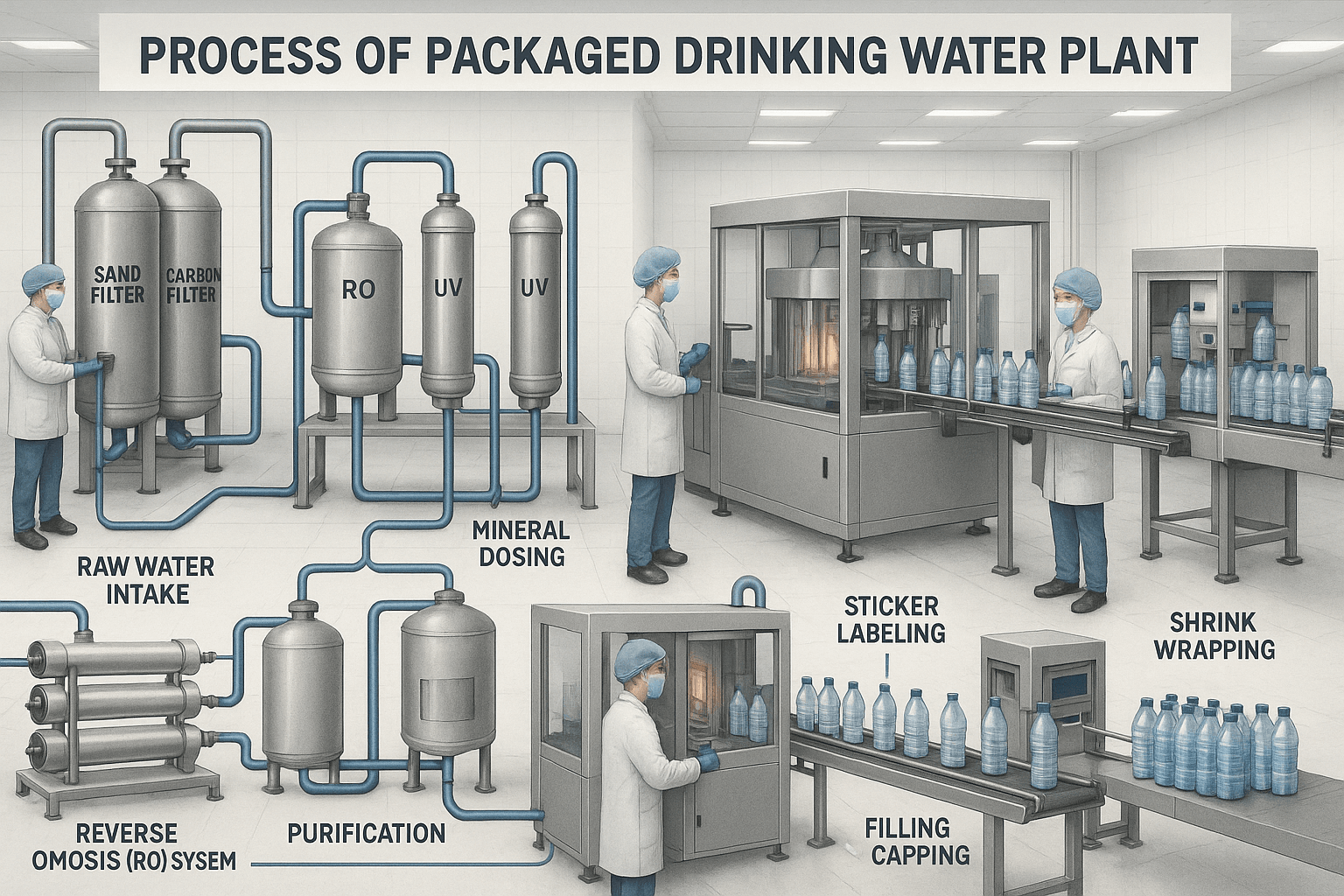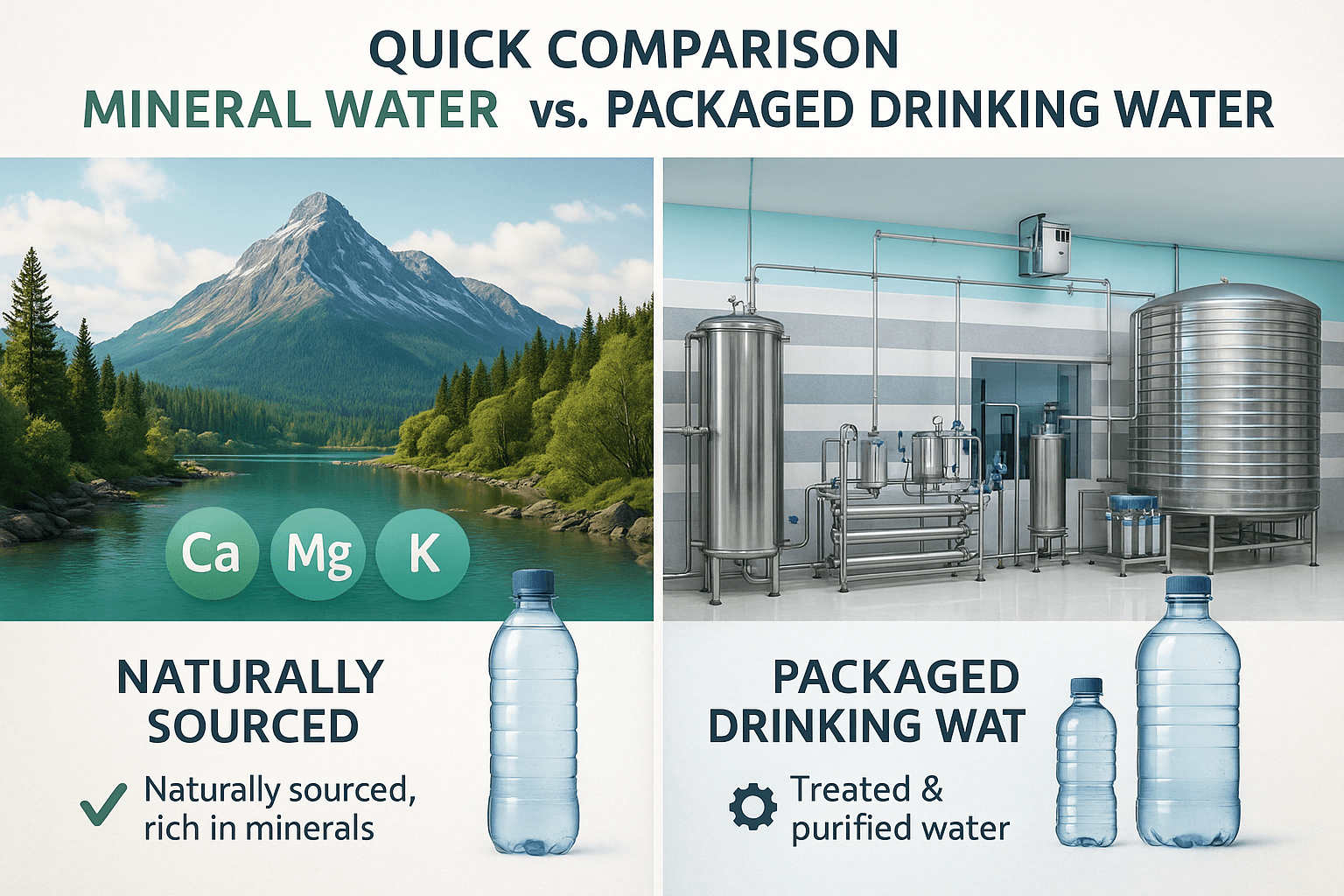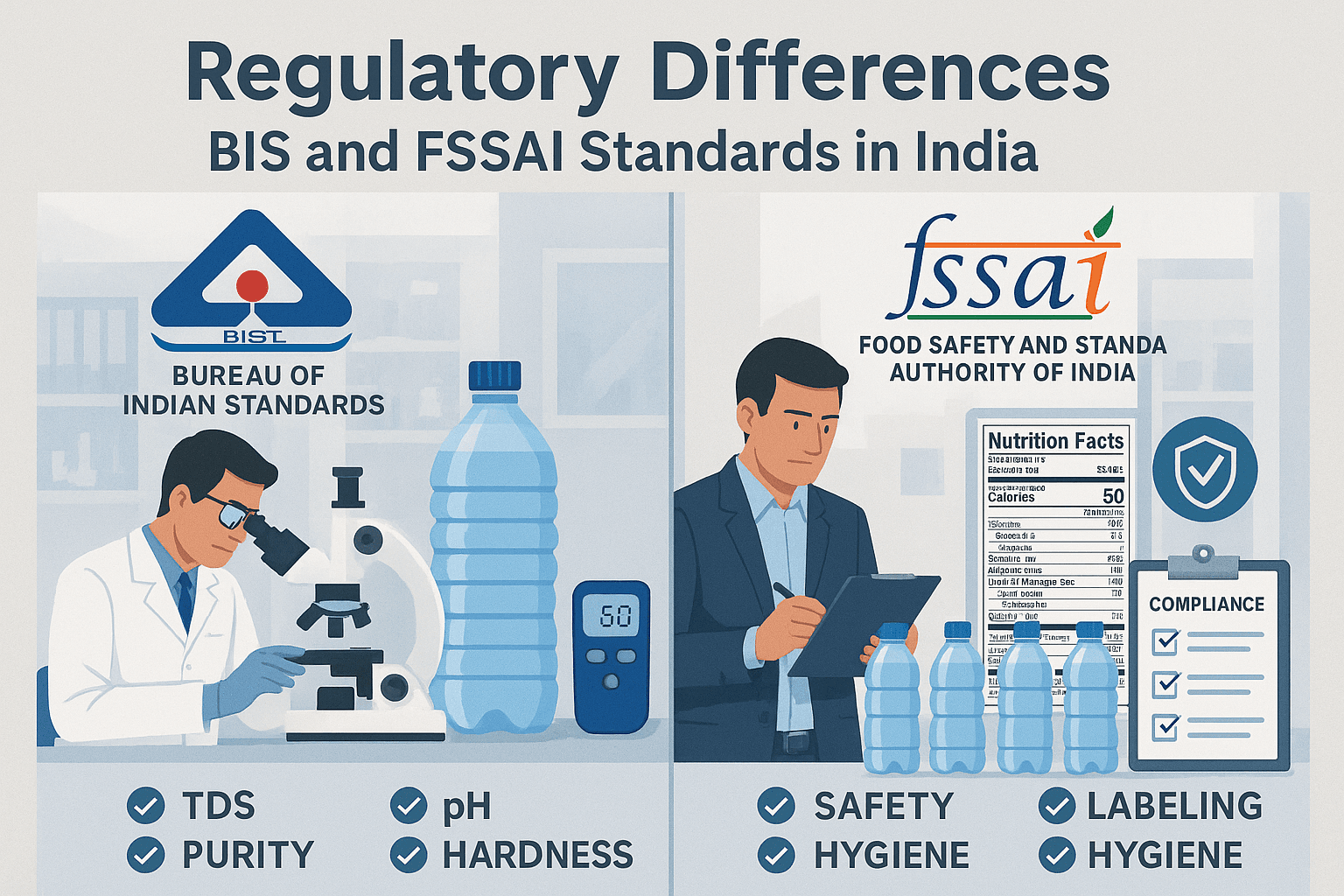
Table of Contents
Difference Between Mineral And Packaged Drinking Water
July 9, 2022
The key differences between mineral and packaged drinking water should be carefully understood.
Understanding the Core Difference Between Mineral and Packaged Water
Mineral water and packaged drinking water might look similar on shelves, but they’re fundamentally different in terms of origin, treatment, and content.
- Mineral water is sourced from natural underground springs or aquifers and contains naturally occurring minerals like calcium, magnesium, and potassium.
- Packaged drinking water, on the other hand, can be sourced from municipal supplies, rivers, borewells, or any freshwater source and is then treated extensively to remove impurities. Minerals may be added during processing to enhance taste or nutritional profile.
This distinction is key to understanding their health implications, regulation, and consumer perception.
Natural Mineral Water
Natural mineral water was already rich with vital mineral components. This water is taken from sources of natural water, and this water already contains essential minerals. Natural water sources such as fountains, waterfalls and rivers are filled with unique minerals and salts from the particular region’s stones and soil. This water has a good taste and is good for health but is not always suitable for human consumption in its raw form.
Process of Natural Water Drinking Plant
- RAW WATER PUMP – Its purpose is to boost raw water to the sand filter. It comes with a flow of 20000 LPH, op, and pressure of 2.5-3.5Kg/cm2.
- SAND MEDIA FILTER – It’s a vertical pressure vessel to remove> 50-micron dusts & other suspended particles. It requires a backwash every day when you start the machine.
- CARBON MEDIA FILTER – It removes colour, odour, chlorine particles and organic impurities. It requires backwash every day when you start the machine, types of media used are Sand, Pebbles, and Gravel. It has a flow of 20000 LPH, op, and pressure of 2.5-3.5Kg/cm2.
- MICRON CARTRIDGE FILTER – It removes>5micron suspended particles. Size of 20″ x 4″, with a filter type of Spun/string wound and a flow of 20000 LPH.
- STORAGE TANK – Its function is to store water upto 5000ltr
- ULTRA VIOLET SYSTEM – It helps deactivate the strength of the bacteria.
- OZONATOR SYSTEM- Its function is to increase the shelf life of water by adding ozone.
- OZONE CIRCULATING PUMP- To circulate ozone water.
- CONTROL PUMP- To monitor pressure at every stage.
Packaged Drinking Water
Packaged drinking water is regular water taken from a fresh and pure source which is cleansed and filtered through a production procedure. It is then packed and made suitable for human consumption. It depends on the bottling brand to add minerals into this water.

Process of Packaged Water Drinking Plant
- RAW WATER PUMP – Its purpose is to boost raw water to the sand filter. It comes with a flow of 20000 LPH and op. the pressure of 2.5-3.5Kg/cm2
- SAND MEDIA FILTER – It’s a Vertical pressure vessel type to remove> 50-micron dusts & other suspended particles. It requires a backwash every day when you start the machine.
- MEDIA FILTER – It removes colour, odour, chlorine particles and organic impurities. It requires backwash every day when you start the machine, types of media used are Sand, Pebbles, and Gravel.
- MICRON CARTRIDGE FILTER – It removes>5micron suspended particles.
- ANTISCALANT DOSING PUMP- Scaling resistance for membrane and increasing membrane life.
- HIGH-PRESSURE PUMP – It is used to lift Profiteered water towards RO Module and is of Vertical multistage centrifugal type.
- R/O SKID- To support the R/O module.
- R/O MODULE- Function to remove physical & chemical impurities in terms of total dissolved solids up to 90 to 95%.
Item membrane housing with membrane mounted on the skid. This film is a composite of a spiral wound.
- OZONATOR SYSTEM- Its function is to increase the shelf life of water by adding ozone.
- OZONE CIRCULATING PUMP- To circulate ozone water.
- CONTROL PUMP- To monitor pressure at every stage.
- Mineral Water: Requires minimal intervention. The goal is to retain natural minerals while removing suspended particles, pathogens, or excess iron/manganese. Technologies used include sand filtration, carbon filtration, UV or ozone disinfection. Excessive chemical treatment is not permitted to preserve mineral integrity.
- Packaged Drinking Water: Goes through extensive purification:
- Reverse Osmosis (RO): Removes 90-99% of dissolved solids, salts, and potential contaminants
- UV/Ozone/Chlorine Treatment: Ensures microbial safety
- Remineralization (optional): Some plants add calcium/magnesium back into RO-purified water for better taste or health profile
The taste experienced with mineral water differs considerably from packaged drinking water. The rich mineral content makes mineral water taste almost the same as fresh, natural water. Additionally, the taste of packaged drinking water may vary based on the source quality, usage of a specific treatment method and content of natural minerals. Packaged drinking water is filtered chemically and treated, mostly done through chlorination. The packaged drinking water goes through various procedures to eliminate all water-based contaminants.
What is Remineralization?
After undergoing RO purification, most natural minerals are removed from packaged drinking water, leaving it “flat” in taste and nutrient-poor. To correct this, some plants follow a remineralization step, adding measured amounts of calcium, magnesium, and other salts back into the water. This not only improves taste but helps restore electrolyte balance for consumers. However, these minerals are added artificially, unlike in mineral water where they occur naturally from the source.
Shelf Life and Storage Differences
Mineral water and packaged drinking water also differ in terms of shelf life and storage requirements. Mineral water, being sourced naturally and retaining its mineral content, usually has a longer shelf life if stored properly in sealed bottles. On the other hand, packaged drinking water, which undergoes processes like demineralization and re-mineralization, often has a shorter recommended shelf life. Storage conditions also vary: both types need to be kept away from direct sunlight and heat, but mineral water is more sensitive to environmental factors as exposure can alter its mineral composition. Highlighting shelf life differences helps consumers make better purchase and storage decisions.
Health Implications: Benefits & Concerns
- Mineral Water Benefits: Naturally rich in electrolytes and minerals, it may support bone health (calcium), regulate blood pressure (magnesium, potassium), and assist in digestion (sulfates, bicarbonates).
- Packaged Water Pros/Cons: While it guarantees microbiological safety, many purification methods like RO can strip beneficial minerals-especially if remineralization isn’t done. Also, long-term consumption of low-mineral RO water may not be ideal without a balanced diet.
- Risk Factors: Excessive consumption of hard mineral water (with too much sodium or calcium) or unregulated bottled water can lead to kidney stress, especially in sensitive individuals.
Regulatory Differences: BIS and FSSAI Standards in India
In India, two distinct regulatory codes apply depending on the type of water:
- Natural Mineral Water: Regulated under IS 13428 by the Bureau of Indian Standards (BIS) and FSSAI. The source must be protected, registered, and monitored for consistent mineral quality.
- Packaged Drinking Water: Falls under IS 14543, which mandates comprehensive purification, microbiological safety, and packaging standards but does not require the presence of natural minerals.
Every bottle must display relevant IS numbers and FSSAI licensing to ensure transparency and legal compliance.
Cost Factor and Market Perception
Another key point of comparison is the cost difference between mineral water and packaged drinking water. Mineral water, sourced from natural springs or underground reserves, is generally priced higher because of limited availability and brand positioning as a premium product. Packaged drinking water, produced using purification systems, is more affordable and widely accessible, making it the preferred choice for mass consumption. From a market perception angle, mineral water is often associated with luxury, while packaged drinking water is considered an everyday necessity. This distinction plays an important role in consumer buying behavior.

Quick Comparison: Mineral Water vs. Packaged Drinking Water
| Feature | Mineral Water | Packaged Drinking Water |
| Source | Underground springs / natural aquifers | Borewells, rivers, municipal sources |
| Minerals | Naturally occurring | May be absent or added artificially |
| Processing | Minimal (filtration, UV/ozone) | Extensive (RO, UV, ozonation, remineralization) |
| Taste | Natural and varies by source | Neutral or altered by added minerals |
| Regulation (India) | BIS IS 13428, FSSAI | BIS IS 14543, FSSAI |
| Shelf Life | Shorter (due to limited treatment) | Longer (due to higher disinfection) |
| Health Value | Contains natural electrolytes | Varies based on treatment and remineralization |
Environmental Impact of Production and Packaging
While focusing on health and purity, it is also important to consider the environmental footprint of both mineral and packaged drinking water. Mineral water extraction can sometimes strain natural reserves if not managed sustainably. Packaged drinking water, although more accessible, contributes heavily to plastic waste due to mass-scale bottling. Recycling efforts and use of biodegradable packaging are still in progress in many regions. Adding this perspective helps readers understand that the choice between mineral and packaged water is not just about health but also about environmental responsibility.
CONCLUSION
Having an insight into the different processes of natural and packaged water drinking plants, it is noteworthy that apart from the R/O module, the entire process is identical. The packaged drinking water goes through various procedures to eliminate all water-based contaminants. The costs for packaged water are also higher than mineral water in the case of RO plants. We at Dharmanandan Technology PVT. LTD a leading mineral water plant and bottling plant manufacturer can give you the best solutions for both sources of water.

Director – Global Marketing and Sales
Mr. Bhavesh from Dharmanandan Techno Projects Pvt. Ltd. has played a pivotal role in elevating the DTPPL brand to the global stage, leveraging his exceptional expertise in marketing and communications. He is committed to helping clients achieve significant growth while strengthening their own brands. Dharmanandan Techno Projects Pvt. Ltd. is a leading manufacturer and supplier of water purification systems and turnkey solutions for mineral water plants. With years of experience in designing and delivering high-quality water treatment solutions, the company provides end-to-end services, including system design, installation, maintenance, and ongoing support. Specializing in scalable and customizable water plants, DTPPL has successfully served industries worldwide, ensuring clean and safe drinking water across diverse applications.

